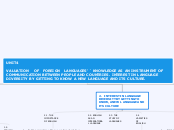UNIT4
VALUATION OF FOREIGN LANGUAGES'´ KNOWLEDGE AS AN INSTRUMENT OF COMMUNICATION BETWEEN PEOPLE AND COUNTRIES. INTEREST IN LANGUAGE DIVERSITY BY GETTING TO KNOW A NEW LANGUAGE AND ITS CULTURE.
1. VALUATION OF FOREIGN LANGUAGES' KNOWLEDGE AS AN INSTRUMENT OF COMMUNICATION BETWEEN PEOPLE AND COUNTRIES
1.1. ASPECTS OF TEACHING A MODERN LANGUAGE
1. Formative aspect. The learning of a foreign language contributes to development of pupils' personality.
2. Social aspect. The development of people carries out in the society.
3. Cultural aspect. The knowledge of other cultures is really important because pupils can acquire a better comprehension of other people.
4. Linguistic aspect. The acquisition of a linguistic knowledge has to be focused on the immediate practice.
1.2. ENGLISH IN THE PRESENT WORLD
2. INTEREST IN LANGUAGE DIVERSITY BY GETTING TO KNOW, A NEW LANGUAGE AND ITS CULTURE
2.1. THE IMPORTANCE OF ENGLISH
1. Politics importance. Many countries which have English as a second language, they sometimes use English in many politics debates. One of these countries is India.
2. Economics importance. English is an indispensable requirement for people who look for a job and it is the language for business.
3. Cultural importance. lt is really important to know the customs, food and the different ways of life of other countries if you want to learn that language.
4. Scientific importance. Most of the scientific books are written in English. Far that reason, a scientist has a clear disadvantage in every field without being able to speak English.
2.2. ENGLISH AS AN INTERNATIONAL LANGUAGE
2.3. THE STUDY OF LANGUAGES
2.4 VARIETIES OF ENGLISH
- Regional variety
- Social and educative variety
- Theme variety
- Environment variety
- Attitude variety
- Interference variety
2.5. TEACHING CULTURE
1. Establishing a sphere of interculturality: Understanding a foreign culture requires putting the culture in relation with one's own. We must reflect upon both the English and Spanish culture, not in isolation but how they both affect each other.
2. Teaching culture as an interpersonal process: language as social practice sees, therefore it is useless to try and teach normative phenomena in the field of culture. We cannot analyse cultural differences in a logical way, but we can highlight general cross-cultural aspects of our own society.
3. Teaching culture as difference: This refers to the fact that our identities are complex and vary. We have to specify many other cultural factors such as: age, ethnic background, sex, social class an regional origin.
Being Spanish or being English is just part of my culture, and these national traits do
not embody our whole personal cultural image.
4. Crossingdisciplinary boundaries: We, as teachers of modern languages, must not think of ou subject in an isolation way. It concludes aspects of geography, history, politics, economics, literature and so on.
3. LANGUAGE DIVERSITY OF SPAIN
3.1. DIFFERENT LANGUAGES AND DIALECTS
